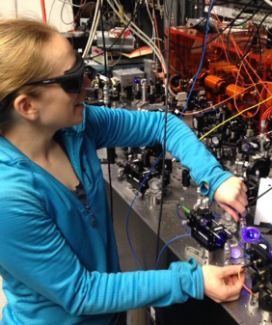Former JILAn Dr. Sara Campbell won the 2018 American Physical Society’s Carl E. Anderson Division of Laser Science Dissertation Award for her doctoral work on the world’s most precise atomic clock.
Campbell’s thesis, entitled “A Fermi-degenerate three-dimensional optical lattice clock”, detailed how the high densities of a degenerate Fermi gas held in an optical lattice could be used to prevent interaction shifts. In this thesis, Campbell demonstrated an unprecedented level of atom-light coherence.
Sara Campbell was a JILA graduate student in the Ye group until May 2017. She is now studying phase contrast electron microscopy as a postdoctoral researcher at Berkeley. Earlier this month, Campbell was named a HHMI Hannah Gray Fellow.
The Carl E. Anderson Division of Laser Science Dissertation Award was established by the American Physical Society in 2013 to recognize novel applications of light-matter interactions in doctoral research, and to encourage effective written and oral presentations. Previous recipients include former JILAn Dr. Dennis Gardner Jr., who won in 2017 for his thesis which demonstrated the highest resolution-to-wavelength ratio ever achieve with coherent diffractive imaging.



 The Physics Frontiers Centers (PFC) program supports university-based centers and institutes where the collective efforts of a larger group of individuals can enable transformational advances in the most promising research areas. The program is designed to foster major breakthroughs at the intellectual frontiers of physics by providing needed resources such as combinations of talents, skills, disciplines, and/or specialized infrastructure, not usually available to individual investigators or small groups, in an environment in which the collective efforts of the larger group can be shown to be seminal to promoting significant progress in the science and the education of students. PFCs also include creative, substantive activities aimed at enhancing education, broadening participation of traditionally underrepresented groups, and outreach to the scientific community and general public.
The Physics Frontiers Centers (PFC) program supports university-based centers and institutes where the collective efforts of a larger group of individuals can enable transformational advances in the most promising research areas. The program is designed to foster major breakthroughs at the intellectual frontiers of physics by providing needed resources such as combinations of talents, skills, disciplines, and/or specialized infrastructure, not usually available to individual investigators or small groups, in an environment in which the collective efforts of the larger group can be shown to be seminal to promoting significant progress in the science and the education of students. PFCs also include creative, substantive activities aimed at enhancing education, broadening participation of traditionally underrepresented groups, and outreach to the scientific community and general public.